cyberarts
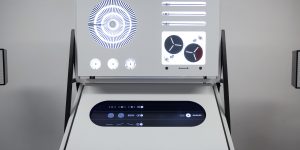
APPARATUM
panGenerator (PL)
Digital interface meets purely analogue sound. The APPARATUM was inspired by the heritage of the Polish Radio Experimental Studio — one of the first studios in the world to produce electroacoustic music. The installation draws inspiration musically and graphically from the “Symphony – Electronic Music” composed by Bogusław Schaeffer. Here, analogue sound generators, based on magnetic tape and optical components, are controlled via a graphic score with a digital interface. NOTE: You can create and listen to your own composition, print out your score and retrieve it in the online archive of APPARATUM.
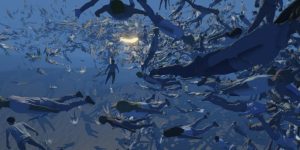
Emergence
Universal Everything (GB)
Emergence is an open-world environment and crowd performance. The virtual reality installation expresses the primal human desire to maintain individual identity while being part of a crowd. As the user navigates a crowd of thousands, shafts of light beckon them closer. As they touch the light, the environment responds in real time, continually challenging the user's perception. In this installation, Universal Everything experiments with software-based improvisation and custom-coded crowd simulations.

VFRAME: Visual Forensics and Metadata Extraction
Adam Harvey (US), Josh Labouve (US)
In conflict zones around the world, serious human rights violations repeatedly occur through the use of illegal munitions. VFRAME shows how surveillance technologies can be used to document such violations – for example in the Syrian conflict. A visual search engine was trained to analyze video data sets from battle zones to spot such weapons. In order to train the neural network of the search engine to recognize them even in low-resolution recordings, 3D models were created and fed into the object detection software.
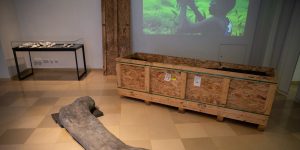
Fossil Futures
Nora Al-Badri (DE), Jan Nikolai Nelles (DE)
"Oskar" is what Germans affectionately call "their" Dino, the world's largest dinosaur skeleton, which is at home in Berlin's Museum of Natural History. Nora Al-Badri and Jan Nikolai Nelles tried to find out where it originally came from and how it finally landed here. They received little information from the public authorities, but with the help of leaked data, artificial intelligence and 3D scans, the history of the fossil could be reconstructed. The trail led to the south of Tanzania. Under German colonial rule, tons of petrified bones were found there and brought to Germany. Using state-of-the-art technology – including a "Virtual Reality Museum" – Fossil Future poses the question of stolen identity, cultural heritage and public property.

Voices from AI in Experimental Improvisation
Tomomi Adachi (JP), Andreas Dzialocha (DE), Marcello Lussana (IT)
Through machine learning, computers can recognize patterns in a variety of sound documents. But can they also learn to improvise musically? The software “Tomomibot” tries it out by interacting in real time with the sound artist Tomomi Adachi, using deep learning techniques. The Artificial Intelligence (AI) "learns" the artist’s individual style via voice recordings and directly confronts him with the newly generated material. Their joint performance shows how interactive technology and AI can influence a (vocal) style. However, this dialogue also makes clear that the artist will always be more creative and unpredictable than his mechanical counterpart.
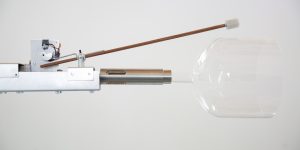
Smart.ing Bodies
Evelina Rajca (PL)
Sand, or to put it more precisely high-purity silicon dioxide particles, is the essential raw material from which we make concrete, glass, fiberoptic cables, computer chips, and other high-tech hardware. The installation Smart.ing Bodies features “glass instruments” made of quartz sand that Evelina Rajca collected from disappearing beaches and mountains around the world. The multisensory sound installation consists of those two glass resonators, sensors, motors, and an algorithmic composition created partly by AI learning processes. In order to keep on playing and to avoid a “resonance disaster” (the destruction of the glass or motor), the algorithmic program has to learn to conduct a variety of smart frequencies. What can be heard is the sound of sand, which is pure yet complex and ever-changing.
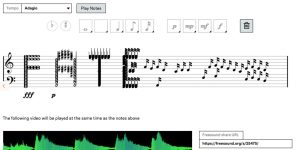
Wiki-Piano.Net
Alexander Schubert (DE)
Wiki-Piano.Net is a composition for piano that can be co-designed by internet users. Everything that the community has made available on the website will be performed on stage. This can be not only music, but also texts, images, or other content. For the musical realization of this score, the performing pianist has piano, keyboard, and his own voice at his disposal. It is not possible to study and practice this composition in the classical sense, but it is not the masterpiece either that is in the foreground of this project. Rather, it is a matter of continuous observation and playful exploration of community behavior and internet use.
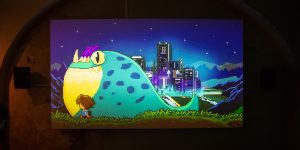
Strings
Ruini Shi (CN)
Strings is a poetic animation in the style of early computer games. In this setting the main character is in search of his lost love in an obsolete online game. The film tells a story about mediated intimacy by depicting a range of virtualized spaces or realms in a game, aiming to open up new ways of thinking about digitally mediated relationships.
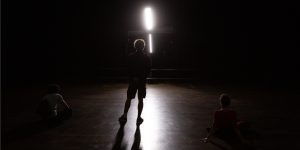
TORSO #1
Peter Kutin (AT)
TORSO #1 is a sound sculpture that is visually reminiscent of a klopotec. This windmill-like wooden construction serves as a scarecrow in vineyards as it mechanically generates sounds and vibrations. Here, an electro-acoustic system of four 100 V loudspeakers rotates at different speeds, generating feedback patterns and modulating sound signals and the spatial sound itself. The targeted acceleration and deceleration of the rotating of the four-voice system serves as the central compositional means for the 35-minute piece – the sculpture becomes an abstract, audiovisual instrument. Warning: The stroboscope-like visual stimuli can cause physical discomfort (dizziness, nausea, etc.) or epileptic seizures in susceptible individuals.


